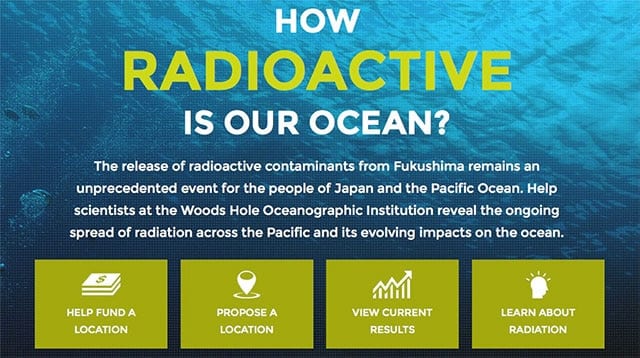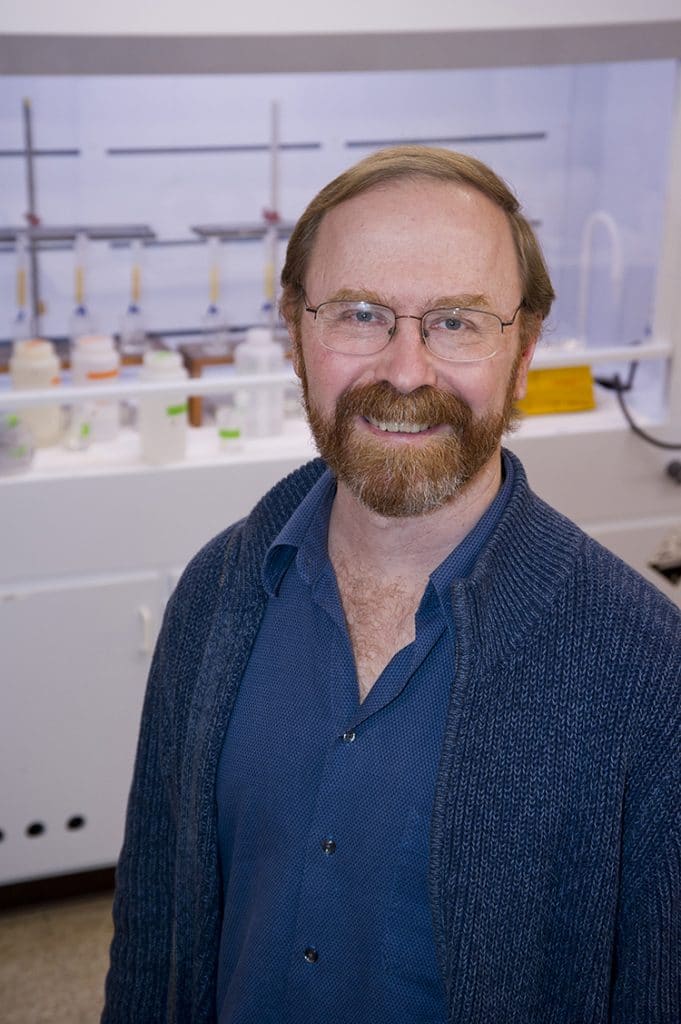Crowdsourcing Fukushima Update
May 13, 2014
How Radioactive is our Ocean?
Coastal communities from Alaska to southern California have joined Woods Hole Oceanographic Institution (WHOI) marine chemist Ken Buesseler to monitor marine radioactivity levels. More than three years after the Fukushima Dai-ichi nuclear power plant accident in Japan, questions remain about how much radioactive material has been released and how widely and quickly it is dispersing across the Pacific Ocean. No U.S. government agency is monitoring this. Buesseler will give a series of public talks in California, Oregon, and Canada from May-June and will be available for media interviews. (See schedule below.)
Buesseler’s Center for Marine and Environmental Radioactivity (CMER) at Woods Hole Oceanographic Institution, a private non-profit marine research and education organization, is partnering with the public to collect seawater samples and raise funds for analyses that provide the latest information about radiation levels in the ocean.
All of the data is being published on the website, How Radioactive is Our Ocean? Since the project and website launched in January 2014, the public has responded with support.
By the Numbers (updated 5/29/14):
- 30 sites are funded for study
- 30 sites are raising funds
- 34 organizations have become supporters*
- 320 donations received
- $50,280 raised
- 110,000 visits to the website
Concerned citizens, foundations, and businesses have come together to monitor our oceans and provide the latest, most accurate information about marine radioactivity levels along the Pacific Coast. In addition to the many individuals who have supported the project, the Pacific Blue Foundation contributed $7,200 for multiple sampling in La Jolla, Calif. and LUSH Cosmetics contributed $12,000 to the project.
“It’s been inspiring to see this diverse group of sponsors from surfers to school children, who all share the concern over our ocean’s health, come together. Because of this unique collaboration, we’ve been able to begin building the most comprehensive dataset on radioactivity levels in the ocean along the west coast of North America since the Fukushima nuclear power plant disaster,” said Ken Buesseler, WHOI marine chemist and CMER director, who launched the crowdsourcing project.
*List of supporters:
Alaska Ocean Observing System
Alaska SeaGrant
Bamfield Marine Science Centre
Cook Inletkeeper
David Suzuki Foundation
Deerbrook Charitable Trust
Dominical Real Estate
Gordon and Betty Moore Foundation
Gwaii Haanas National Park Reserve, Parks Canada
Humboldt State University, Marine Lab
Idaho Section of the American Nuclear Society
KUSP Santa Cruz
Norton Sound Economic Development Corporation
Nuxalk Nation
Onset Computer
Pacific Blue Foundation
Picture Farm
Point Blue Conservation Science
Prince William Sound Science Center
Resurrection Bay Conservation Alliance
San Luis Obispo Mothers for Peace
Santa Barbara Channel Keeper
Say Yes! to Life Swims LLC
Scripps Institution of Oceanography
Southwest Alaska Inventory and Monitoring Program, National Park Service
The Guacamole Fund
The Institute for Building Biology and Ecology
Tillamook Estuaries Partnership
Ucluelet Aquarium
Umpqua Soil & Water Conservation District
University of California Davis, Marine Pollution Studies Lab
University of Hawaii
West Hills STEM Academy
Woods Hole Oceanographic Institution
“Although radioactivity can be dangerous, the amount and concentration of Fukushima radiation that models predict this year on the West Coast of North America will be of little human health concern. But we need sampling to test those models and that’s why we believe monitoring it in the ocean is so important,” Buesseler said.
So far, none of the seawater samples taken from the Pacific Coast have contained any trace of radiation from Fukushima. They have contained the same levels of radiation that were evident in the Pacific Ocean before the Fukushima accident. These levels of cesium-137 measured at all sites are between 1 and 2 Bequerels per cubic meter, and are from the 1960s atmospheric nuclear weapons testing programs.
The lack of cesium-134, which only has a two-year half life for radioactive decay, indicates that none of the Fukushima contaminants have reached the West Coast sampling sites. Therefore, continued support for monitoring is needed as the cesium isotopes are expected to reach the coast in 2014 and levels are predicted to increase over the coming 2-3 years.
“We use some of the most sensitive techniques to measure cesium isotopes in the ocean, and the lack of any cesium signal from Fukushima so far, is not surprising, but confirms our need to diligently monitor for what is spreading across the Pacific and is likely to be detected along our shores some time this year,” Buesseler said.
Additional support is needed for CMER’s on-going efforts to train the next generation of marine radiochemists and to purchase additional cesium gamma detectors. Support can be given by donating to the capacity building campaign.
Support thus far from over 320 donations has made the monitoring effort possible and all data are posted online for each sampling in the “view results” pages.
To help convey these early results and what they mean to the public, and to meet with local groups who are taking part with our radioactive ocean, Dr. Buesseler will give a series of public talks on the West Coast in California, Oregon, and Canada from May 27-June 5, 2014. Here is the schedule of events.
May 27 Presenting Fukushima: A View from the Ocean at the University of California at Santa Barbara, Campbell Hall at 7 p.m.
May 31 Presenting Citizen Science: Monitoring Fukushima Radiation at Santa Rosa Junior College’s Petaluma campus, Carole Ellis Auditorium at 7 p.m. with Dan Sythe, CEO International Medcom. Sponsored by the SRJC Chemistry Dept. and Physics Program.
June 2 Our Radioactive Oceans music, silent auction, and talk at The Refuge in Portland, Oregon from 5:30-9 p.m. $5-$10 donation at the door. No one will be turned away for lack of funds.
June 5 Presenting Fukushima: A View from the Ocean at the Vancouver Aquarium at 9 a.m. in Vancouver, Canada.
June 5 Presenting Fukushima: A View from the Ocean at St. Anne’s Academy Auditorium at 7 p.m. in Victoria, Canada.
Ken Buesseler is a Senior Scientist at the Woods Hole Oceanographic Institution (WHOI) who specializes in the study of natural and man-made radionuclides in the ocean. His work includes studies of fallout from atmospheric nuclear weapons testing, assessments of Chernobyl impacts on the Black Sea, and examination of radionuclide contaminants in the Pacific resulting from the Fukushima nuclear power plants. Dr. Buesseler has served as Chair of the Marine Chemistry and Geochemistry Department at WHOI, as Executive Scientist of the U.S. Joint Global Ocean Fluxes Planning and Data Management Office, and two years as an Associate Program Director at the U.S. National Science Foundation, Chemical Oceanography Program. In 2009, he was elected Fellow of the American Geophysical Union and in 2011 he was noted as the top cited ocean scientist by the Times Higher Education for the decade 2000-2010. He is currently Director of the Center for Marine and Environmental Radioactivity at WHOI. For more info, visit his lab, Café Thorium.
The Woods Hole Oceanographic Institution is a private, non-profit organization on Cape Cod, Mass., dedicated to marine research, engineering, and higher education. Established in 1930 on a recommendation from the National Academy of Sciences, its primary mission is to understand the ocean and its interaction with the Earth as a whole, and to communicate a basic understanding of the ocean’s role in the changing global environment. For more information, please visit www.whoi.edu.


